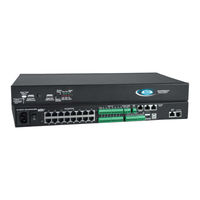NTI ENVIROMUX E-5D Manuals
Manuals and User Guides for NTI ENVIROMUX E-5D. We have 3 NTI ENVIROMUX E-5D manuals available for free PDF download: Installation And Operation Manual, Manual
NTI ENVIROMUX E-5D Installation And Operation Manual (150 pages)
Enterprise Environment Monitoring System
Brand: NTI
|
Category: Measuring Instruments
|
Size: 10 MB
Table of Contents
Advertisement
NTI ENVIROMUX E-5D Manual (59 pages)
Enterprise Environment Monitoring System
Brand: NTI
|
Category: Measuring Instruments
|
Size: 3 MB
Table of Contents
NTI ENVIROMUX E-5D Manual (4 pages)
RESTORE DEFAULTS VIA RS232
Brand: NTI
|
Category: Measuring Instruments
|
Size: 0 MB
Table of Contents
Advertisement
Advertisement


